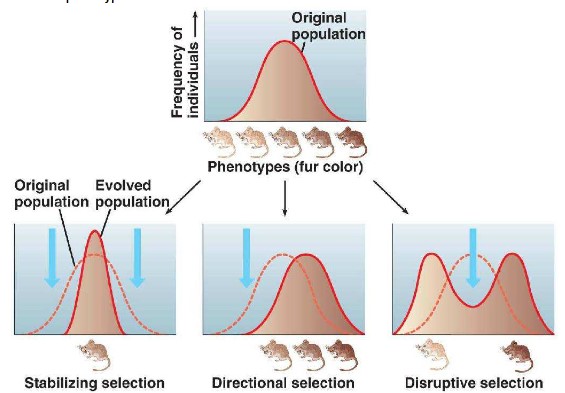Topic 10: Genetics and evolution (HL)
10.3 Gene pool and speciation
Gene pool:
- A gene pool is the total collection of different alleles in an interbreeding population.
- Evolution is the cumulative change in allele frequency or heritable characteristics in a population over time
- The cumulative change can occur as a result of genetic mutations and selective pressures which favour certain heritable characteristics over other less favourable characteristics
- Allele frequency: is the proportion of all copies of a gene that is made up of a particular gene variants (allele)
- These populations have to be reproductively isolated, thus preventing gene flow between populations
- If a population that has a certain allele or characteristic is quite small, random events such as disease or natural disasters can cause a drastic drop in this particular allele
- Speciation: the creation of new species.
Selective pressure:
Directional Selection:
Selection that removes individuals from one end of a phenotypic distribution and thus causes a shift in the distribution towards the other end. This occurs when natural selection favours one extreme end of the continuous variation of phenotypes. Over time, the favoured extreme will become more common and the other extreme will be less common or lost. For example, dark mice are favoured because they live in an area that favours that phenotype. It leads to preference of a certain phenotype.
Stabilizing Selection:
A type of selection that removes individuals from both ends of a phenotypic distribution, thus maintaining the same distribution mean. This occurs when natural selection favours the intermediate phenotypes. Over time, the intermediate states become more common and each extreme variation will become less common or lost. Same mouse example where medium coloured fur is favoured over dark or light fur colour. Concentrated in a single phenotype.
Disruptive Selection:
A type of selection that removes individuals from the center of a phenotypic distribution and thus causes the distribution to become bimodal. This occurs when natural selection favours both ends of the phenotypic variation. Over time, the two extreme variations will become more common and the intermediate states will be less common or lost. Disruptive selection can lead to two new species. Light coloured and dark coloured mice might live in an environment with patches of light and dark vegetation making it hard for predators to spot those colours, while the middle coloured mouse doesn’t blend into either background. Selective pressure is on centre of phenotypes

Reproductive isolation:
- Temporal isolation: separating pollination time (breeding time), prevent hybridizing with each others.
- Geographical isolation: separated by geographical event, prevent hybridizing
- Behavioral isolation: courting behaviors differs; they cannot recognize each other so they cannot interbreed.
Speciation:
- Simply stated, speciation can occur gradually over long periods of time, with several intermediate forms in between species leading to today’s current species. This can be seen by some of the more complete fossil records, like the whale.
- However, in some species, large gaps were evident for certain species in the fossil record. This could be explained by possible imperfections in the fossil record, or perhaps, these species have not been discovered yet.
- Another explanation is through abrupt speciation.
- Formation of new species which is reproductively and ecologically isolated from the parental species as a result of a genetic mutation such as a sudden change in chromosome number or constitution
- Genetic mutations such as non-disjunctions of an entire set of chromosomes can cause a doubling of chromosomes (polyploidy) resulting in a different species
- Also interbreeding of two genetically different organisms can produce hybrids which are generally infertile